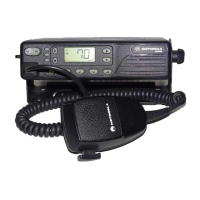Transmitter Power Amplifier (PA) 5-25W
6.3-18 Theory of Operation
The IF amplifier Q5201 is actively biased by a collector base feedback (R5201, R5202) to a current
drain of approximately 5 mA drawn from the voltage 5V STAB. The output impedance is matched to
the second two pole crystal filter Y5202. A dual hot carrier diode (D5201) limits the filter output
voltage swing to reduce overdrive effects at RF input levels above -27 dBm.
8.3 IF IC (U5201)
The first IF signal from the crystal filters feeds the IF IC (U5201) at pin 6. Within the IF IC the
45.1MHz first IF signal mixes with the second local oscillator (LO) at 44.645MHz to the second IF at
455 kHz. The second LO uses the external crystal Y5211. The second IF signal is amplified and
filtered by two external ceramic filters (FL5201, FL5202). Back in the IF IC the signal is demodulated
in a phase-lock detector and fed from IF IC pin 28 to the audio processing circuit AFIC U0103
located in the controller section (line DET AUDIO).
The IF IC also controls the squelch characteristics of the radio. With a few external parts (R5222,
C5229, C5230, R5223) the squelch tail, hysteresis, attack and delay were optimized for the radio. To
set the squelch threshold the signal from IF IC pin 23 (line SQ ATT IN) is attenuated by a
microprocessor controlled audio processing IC AFIC (U0103) located in the controller section. The
attenuated signal from the AFIC (line SQ ATT OUT) enters the IF IC at pin 20 and is used to create
a squelch indicator signal available at pin 15 (CSQ DET).
The microprocessor controlled ADAPT signal at pin 22 activates the fast squelch indicator signal at
IF IC pin 18 (FAST SQ). Both squelch indicator signals CSQ DET (pin 15) and FAST SQ (pin 18) are
combined, weighted by R0111 / R0112 and fed to the microprocessor U0101 pin 15 for
interpretation. From the voltage weighted by the resistors the µP determines whether CSQ DET,
FAST SQ or both are active.
At IF IC pin 11 an RSSI signal is available with a dynamic range of 70 dB. The RSSI signal is
buffered by op-amp U0106-3 and available at accessory connector J0400-15.
9.0 Transmitter Power Amplifier (PA) 5-25W
The transmitter is able to cover the range from 216 to 246 MHz.
The radio’s 5-25 W PA is a four stage amplifier used to amplify the output from the exciter to the
radio transmit level. It consists of four stages in the line-up. The first (Q8510) is a bipolar stage that is
controlled via the PA control line. It is followed by another bipolar stage (Q8520), a MOS FET stage
(Q8530, Q8531) and a final bipolar stage (Q8540). Devices Q8510, Q8520,Q8530 and Q8531 are
surface mounted. Bipolar Transistor Q8540 is directly attached to the heat sink.
9.1 Power Controlled Stage
The first stage (Q8510) amplifies the RF signal from the VCO (line EXCITER PA) and controls the
output power of the PA. The output power of the transistor Q8510 is proportional to its collector
current which is adjusted by a voltage controlled current source consisting of Q8612 and Q8621.
http://www.myradio168.net

